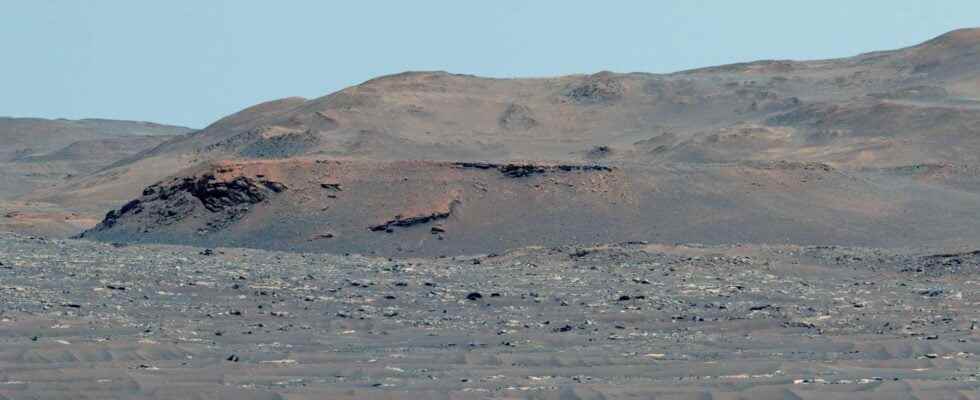Astronomers believed them to be sedimentary, but new data returned to Earth by the NASA Perseverance rover shows that the rocks it has been rolling on since arriving on Mars in February 2020 have formed from volcanic material. Lava may have flowed there in the past and this is completely unexpected news.
It has now been almost a year since Perseverance, the rover of the Nasa, landed on the ground of Mars. Almost a year he travels through the Jezero crater. And researchers who use the data it sends back to Earth have just announced astonishing news. According to them, Perseverance would roll from the beginning on a ground formed of magmatic rocks.
Even before sending their rover there, NASA researchers wondered about the nature of the soil in this crater. They wondered if it was more composed of sedimentary rocks or igneous rocks. The first as a result of the accumulation of mineral particles eventually transported there by an ancient river system. The seconds as a result of the solidification of a magma from a long extinct volcano.
This is thanks to the Pixl tool – for Planetary Instrument for X-ray lithochemistry – that researchers have finally found the answer. The instrument is intended to determine the elemental composition of materials at the surface of mars by X-ray lithochemistry. And it takes advantage of the openings offered by the drill installed at the end of the arm robotic of Perseverance. This, in fact, can abrade or grind rocky surfaces.
Magmatic rocks in the Jezero crater
A few days ago, a rock nicknamed Brac and taken in the south of the Séítah region revealed its composition: large crystals ofolivine engulfed in pyroxene crystals in quite unusual quantities. The mark of a rock formed from crystals deposited in a slowly cooling puddle.
The researchers add that the rock in question was then repeatedly weathered by water. “This makes it a treasure that will allow future scientists to date the events that occurred in the Jezero crater, to better understand the period in which thewater was more common on its surface and to reveal the beginnings of the history of the planet Mars ”, specifies Ken Farley, researcher of the team, in a press release from NASA. It remains to be determined whether this olivine-rich rock formed in a lake of wash thick cooling on the surface or in an underground chamber which has subsequently been exposed by erosion.
Because Perseverance also aims to take samples of Martian rock – in particular to look for traces of life – intended to be brought back to Earth by another mission. What to study in more detail the samples in question.
Exciting first results
The researchers took advantage of a press conference on Wednesday to also recall that the instrument called Sherloc – for Scanning Habitable Environments with Raman & Luminescence for Organics & Chemicals – meanwhile got hold of organic molecules, not only in abraded rocks, but also in non-abraded rock dust. “Enough to map the spatial distribution of organic materials inside rocks and link these organic materials to minerals that are there. This helps us understand the environment in which organic matter was formed. Further analysis needs to be done to determine how these molecules were produced ”, specifies Luther Beegle, responsible for the Sherloc project. No certainty yet regarding proof of life, therefore. But the presence of preserved organic matter seems at least to mean that potential biosignatures could also have been preserved. To learn more, we will have to wait for the samples to return to Earth.
In the meantime, scientists also continue to use the data transmitted by Rimfax – to Radar Imager for Mars’ Subsurface Experiment -, “radargrams” on which appear the underground structures of the Red planet up to 10 meters deep. They have already made it possible to confirm that the Séítah region was formed before that of Crater Floor Fractured Rough. And they should soon bring other valuable information on the geology Martian.
HOME STRETCH ! #LeMagFutura
The countdown has started, the adventure will end very soon … You have until Friday 17/12 to pre-order your copy of Mag Futura and receive it in preview in your mailbox! We are on the starting blocks!
What is Mag Futura? A review of more than 200 pages, 4 files on Science which will mark 2022, zero fake news, just Science !
Why is it important to continue to support us until the last moment?
- To succeed in having a finalized format, up to your expectations: enriched with educational comics, incredible illustrations and ingenious tutorials (objective: 2,500 presales)
- To make Science accessible to the wider world and to ban fake news!
- To demonstrate that the press still has a bright future ahead of it (with 4000 presales: Mag Futura is coming out on newsstands and bookstores).
- To give us hope for the future and ensure the future of the Mag Futura project.
Meeting on Ulule to support the project ! More than ever, we are counting on you!
Interested in what you just read?
.
fs3
